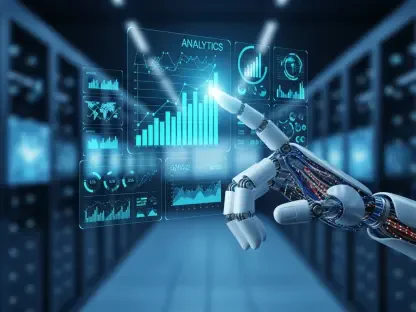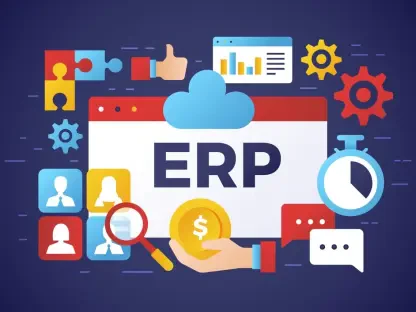The enterprise software landscape is undergoing a seismic shift, with over 70% of businesses projected to integrate autonomous AI systems by 2027, according to recent industry forecasts. This staggering statistic underscores a pivotal transformation, where traditional human-operated software frameworks are giving way to AI-driven models that promise unparalleled efficiency. This review delves into the intricacies of these innovative systems, exploring their core features, real-world impact, and the challenges they present in a rapidly evolving digital era.
Defining the Post-SaaS Paradigm
AI-driven software models represent a groundbreaking approach, where autonomous AI agents serve as the primary operators of enterprise systems, executing tasks with minimal human oversight. Unlike the Software-as-a-Service (SaaS) models that dominated the past, which relied heavily on human interaction, this new paradigm shifts the focus to machine-led operations. These agents initiate workflows, allocate resources, and resolve issues at speeds unattainable by manual processes, redefining operational norms.
This transition to a post-SaaS era marks a departure from user-centric interfaces toward automated, system-driven interactions. The relevance of this shift cannot be overstated, as it aligns with the broader goals of digital transformation, aiming to streamline processes and enhance scalability. Enterprises now face the task of adapting to a landscape where software value is tied to outcomes rather than access, setting the stage for a deeper analysis of these models’ capabilities.
Key Features and Performance Analysis
Functionality of Autonomous AI Agents
At the heart of AI-driven software models lie autonomous AI agents, designed to handle complex enterprise tasks with precision and speed. These agents independently manage workflows, negotiate system resources, and execute operations, drastically reducing the need for human intervention. Their ability to operate continuously without fatigue offers a significant boost to productivity, particularly in high-volume environments.
The performance implications are profound, as these agents can process vast amounts of data and make decisions in real time. For instance, in manufacturing, AI agents have been shown to optimize production schedules, minimizing downtime and enhancing output. However, their effectiveness hinges on robust data architectures and seamless integration with existing systems, a factor that remains a critical consideration for deployment.
Shift to Value-Based Pricing
Another defining feature is the move from traditional per-seat licensing to value-based pricing frameworks, where costs are tied to measurable results like cost savings or completed tasks. This shift reorients software evaluation from mere access metrics to tangible business outcomes, offering a more accurate reflection of value delivered. It also compels vendors to prioritize performance and customer success over user counts.
Strategically, this pricing model alters vendor-customer dynamics, fostering negotiations centered on results rather than headcounts. While this can enhance transparency, it introduces complexities in budget forecasting and contract management. Enterprises must develop new evaluation criteria to assess software investments, ensuring alignment with organizational goals and financial planning.
Industry Applications and Impact
AI-driven software models are making significant inroads across diverse sectors, including manufacturing, retail, automotive, and skilled trades. In manufacturing, these systems have optimized supply chain logistics by predicting demand fluctuations and adjusting inventory in real time, slashing operational costs. Such implementations highlight the potential for AI to address industry-specific pain points with tailored solutions.
In retail automotive, AI agents have streamlined customer service operations by automating scheduling and maintenance tracking, improving client satisfaction rates. Meanwhile, in skilled trades, these models assist with project management, allocating resources efficiently to meet tight deadlines. These varied applications demonstrate the adaptability of AI-driven systems, capable of transforming workflows regardless of sector nuances.
Challenges in Implementation
Despite their promise, adopting AI-driven software models presents notable technical hurdles, such as integrating with legacy systems and ensuring data security. Many enterprises struggle with outdated infrastructures that resist seamless incorporation of AI agents, leading to inefficiencies or system conflicts. Addressing these issues requires substantial investment in modernizing digital frameworks, a barrier for smaller organizations.
Strategically, the shift to outcome-based pricing and governance models poses additional challenges, as traditional procurement practices are ill-equipped for this new landscape. Regulatory considerations also loom large, with data privacy and compliance demands necessitating careful oversight. Enterprises must navigate these complexities to fully harness the benefits of AI-driven systems without compromising operational integrity.
Market resistance further complicates adoption, as stakeholders often hesitate to abandon familiar licensing structures. Overcoming this inertia demands a cultural shift within organizations, alongside updated training programs to align staff with AI-centric workflows. Ongoing efforts to refine digital strategies and establish clear governance protocols are essential to mitigate these adoption barriers.
Future Prospects and Innovations
Looking ahead, the trajectory of AI-driven software models points toward even greater automation, with agent-to-agent interactions expected to become a cornerstone of enterprise operations by 2027. Such advancements could enable fully autonomous ecosystems, where systems communicate and negotiate without human input, driving efficiency to unprecedented levels. This vision, while ambitious, hinges on continued innovation in AI algorithms and system interoperability.
The long-term impact on software consumption is likely to be transformative, reshaping how businesses evaluate and deploy technology. As these models mature, they could unlock new avenues for industry innovation, from predictive analytics to self-optimizing workflows. Keeping pace with these developments will require enterprises to remain agile, investing in scalable solutions that anticipate future needs.
Final Reflections
Reflecting on this exploration of AI-driven software models, the transformative potential of autonomous AI agents becomes evident through their ability to redefine enterprise efficiency. Their performance in diverse industries underscores a marked departure from traditional SaaS frameworks, while the shift to value-based pricing highlights a new era of accountability in software valuation. Challenges in adoption, though significant, do not overshadow the clear benefits observed in optimized workflows and cost reductions.
As a next step, enterprises should prioritize strategic planning to integrate these models, focusing on modernizing data infrastructures and aligning procurement practices with outcome-based metrics. Collaborating with vendors to establish predictable pricing tiers and investing in staff training emerge as actionable measures to ease the transition. Embracing this shift with foresight and adaptability proves to be the key to unlocking the full potential of AI-driven systems in reshaping the digital landscape.









